NCEPOD: Trauma - Who Cares? - London Health Programmes
NCEPOD: Trauma - Who Cares? - London Health Programmes
NCEPOD: Trauma - Who Cares? - London Health Programmes
Create successful ePaper yourself
Turn your PDF publications into a flip-book with our unique Google optimized e-Paper software.
Principal recommendationsAirway and breathingThe current structure of prehospital management isinsuffi cient to meet the needs of the severely injuredpatient. There is a high incidence of failed intubationand a high incidence of patients arriving at hospital witha partially or completely obstructed airway. Changeis urgently required to provide a system that reliablyprovides a clear airway with good oxygenation andcontrol of ventilation. This may be through the provisionof personnel with the ability to provide anaesthesiaand intubation in the prehospital phase or the use ofalternative airway devices. (Ambulance trusts)All patients with severe head injury should be transferredto a neurosurgical/critical care centre irrespective of therequirement for surgical intervention. (Strategic healthauthorities, hospital trusts, trauma team leaders)Paediatric careEach receiving unit should have up to date guidelines forchildren which recognise the paediatric skills available onsite and their limitations and include agreed guidelinesfor communication and transfer with specialisedpaediatric services within the local clinical network.(Strategic health authorities and hospital trusts)Management of circulation<strong>Trauma</strong> laparotomy is potentially extremely challengingand requires consultant presence within the operatingtheatre. (Clinical directors)If CT scanning is to be performed, all necessary imagesshould be obtained at the same time. Routine use of‘top to toe’ scanning is recommended in the adulttrauma patient if no indication for immediate interventionexists. (Royal College of Radiology and radiologydepartment heads)TransfersThere should be standardised transfer documentation ofthe patients’ details, injuries, results of investigations andmanagement with records kept at the dispatching andreceiving hospitals. (<strong>Trauma</strong> team leader, Departmentof <strong>Health</strong>)Published guidelines must be adhered to and audits performedof the transfers and protocols. (Hospital trusts)Head injury managementPatients with severe head injury should have a CT headscan of the head performed as soon as possible afteradmission and within one hour of arrival at hospital.(<strong>Trauma</strong> team leader and radiology heads)Incidence of trauma and organisationof trauma servicesGiven the relatively low incidence of severe traumain the UK, it is unlikely that each individual hospitalcan deliver optimum care to this challenging group ofpatients. Regional planning for the effective delivery oftrauma services is therefore essential. (Strategic healthauthorities, hospital trusts)13
















